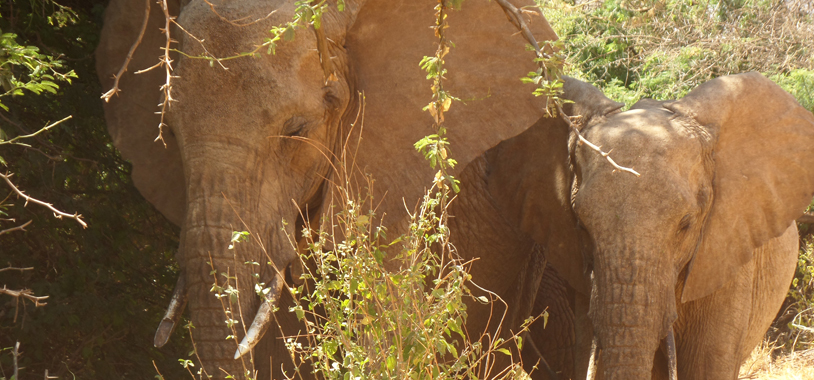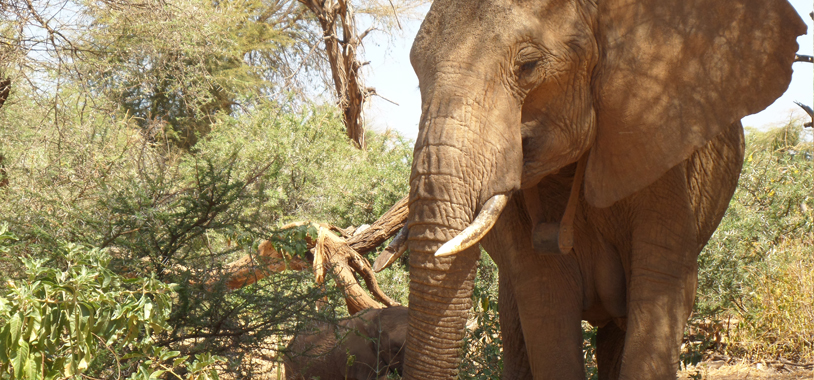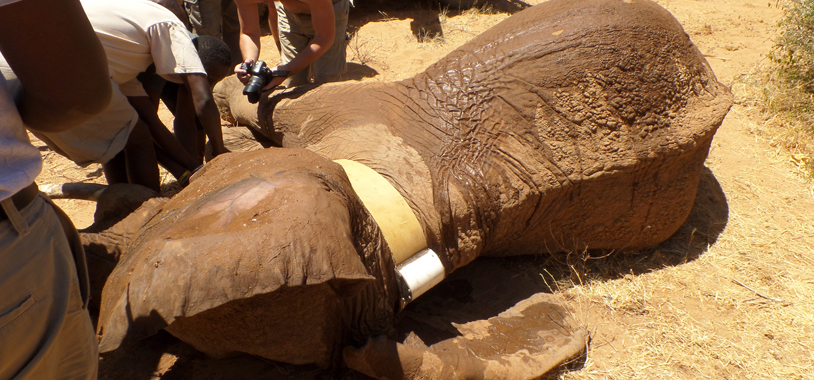Collaring elephants provides researchers and conservation institutions an invaluable insight into elephant life. One such example being the migration paths that they use and when they use them; allowing for informed decisions to be made about wildlife corridors and thereby the reduction of human – elephant conflict.
My previous blog, should you have read it, describes the family history of one of Samburus family herds – the Virtues – and my ever increasing fondness for them. Their matriarch, Amity, is one such collared female that the Save The Elephants research team collects movement data from, since she tends to lead her family outside of Samburu National Reserve for many months of the year. She had previously been fitted with a ‘GSM’ collar, which stored location data until one of the team was able to get close enough to Amity in order to download the back logged data with a receiver. The virtues are a calm and habituated herd, so getting close enough to Amity to download the data posed no problem. However, finding Amity proved far more difficult.
The Virtues had left Samburu on their migration path, not returning for many months. It was vital that the data was downloaded before the memory began to over write itself and it was forever lost, so when the family returned to Samburu, and was spotted by Shifra, Jenna, David and myself – it was imperative that we recovered the data from the collar.
In light of these difficulties, the decision was made to replace Amitys ‘GSM’ collar with a ‘satellite’ collar, that would allow the team to receive real time updates of the family’s location wherever they may be, eliminating the fear of losing data should they not return to Samburu for a while. The procedure would include immobilization of the matriarch, a practice readily criticized by some. The darting and subsequent collaring of Amity would be invasive, but the Save The Elephants team is highly experienced, with the elephants best interests always at the center of all field operations.
On the 12th of February, the vet arrived and all was ready to change the collar, and so we set out to find the family and assess the suitability of area they were in for the darting operation. The sun was hot as we scanned Samburu National Reserve for signs of the family, only managing to spot R13.95B06, Amitys daughter, on the bank of the Ewaso Nyiro before crossing into the bush on Buffalo Springs. Taking her lead, we eventually found Amity peacefully resting under a tree with her most recent calf (R13.95B13) lying nearby. The area, however, was less than ideal for ourselves – littered with hidden logs and thick sand ready to bring the land cruiser to a standstill with every wrong turn.
After a few hours battling the deep sand, the whole family had been located and had moved to rest under a tree. David, the vet and the team evaluated the area and scouted out the possible routes the family could take after the darting – finally deciding that the operation was safe to go ahead. The family was calm as the team split up: one car staying back to retain visual on Amity whilst the other car approached to an appropriate darting position. After a few moments the call came across the radio: “dart in”.
Despite the undoubtedly stressful darting, Amity did not run but instead ambled into view, followed closely by her calf and the rest of her family. The family, as expected of this tight knit group, remained close, rumbling communications to their leader. After 7 minutes, Amity succumbed to the effects of the drug and we witnessed the true strength and depth of this family’s bonds. The scars of their past experience with poachers are clearly deeply embedded, as Verity (R13.03) fiercely defended her sister as the cars surrounded her. Verity placed herself in perceived danger to protect her incapacitated sister with ear piercing trumpets and mock charges to try and drive us away. Her immense affection for her sister was so glaringly obvious to me, it is astonishing that it can be denied that these animals have as deep an emotional life as we do.
Once the family had been driven away to a safe distance (with great difficulty I may add), it was vital that we worked quickly and effectively to ensure minimal discomfort for Amity. Liters and liters of water were poured over her body to keep her cool, as David smoothed a mud paste as a make shift sun screen onto the back of her ear – draping it over her eye to protect it from the sun. Jenna and I set about taking measurements of Amity for future reference as Jerenimo cut through the old collar before fitting the new one. Barely able to hold onto the tape measure as the adrenaline coursed through me, we measured the width and length of her immense feet, her shoulder height, tusk length and circumference as Shifra collected tail hairs for DNA analysis. Before there was time to marvel at the enormous animal we were so close to, the counter weight had been secured and the antidote was administered.
In total, Amity’s collar was replaced in just 12 almost silent minutes before she recovered from the drugs affects. The tension from the on-looking herd was palpable, never having let their matriarch out of their sight. Amity rose to her feet, immediately heading towards her herd, undoubtedly rumbling inaudible assurances of her return to her family. Once together again, the herd moved on to feed in the salt bush – except this time equipped with a collar that will provide real time data of their location, allowing Save The Elephants to make informed management decisions for the protection of their habitat. Amity will not need to be immobilized again for several years, but will be unwittingly providing invaluable information used to safeguard her species future.




